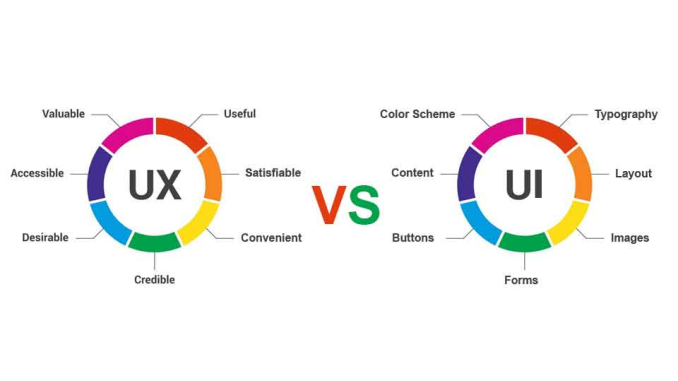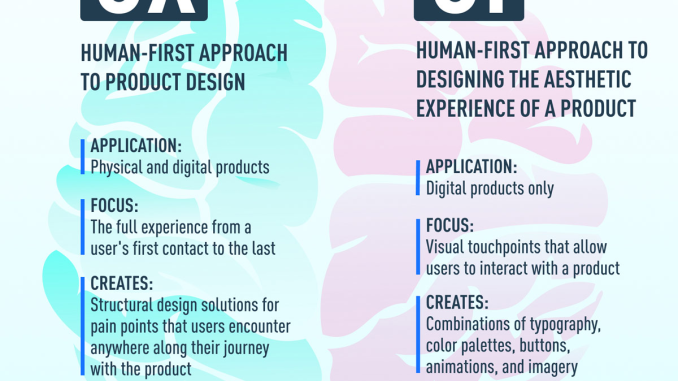Technology-based products are becoming increasingly integral to our daily lives, from apps to websites and beyond. As such, UX and UI designers have become an indispensable part of companies around the world. But what is the difference between these two types of design? To put it simply, UX, or user experience design, is concerned with how a product feels and functions; whereas, UI, or user interface design, is focused on creating an aesthetically pleasing interface for users to interact with.
An experienced UX designer can work to make sure that the product works smoothly and efficiently while also enhancing the overall user experience. On the other hand, experienced UI designers will create a visually appealing interface that enables smooth and intuitive interaction with the product. While often used interchangeably, it’s important to understand the differences between UX and UI design to create effective technology-based products. In this blog post, we’ll explore these differences in more detail.

What is UX design?
UX design, commonly known as user experience design, is an essential area of digital design that focuses on the interaction between a user and the digital product or system. Good UX designers are experienced in optimizing the overall end-user experience through functions, layouts, visuals, and content to ensure quality interactions for each user goal.
Experienced UX designers can analyze and understand user interface elements such as navigation menus, search boxes, and buttons to create easy-to-use digital products. Furthermore, they are familiar with various techniques such as wireframing, prototyping, and the development process necessary to move from one phase of a project to another. All of these skills when combined create an overall seamless user experience that can be applied not just in web and software products but also across other mediums such as television and video games.
UX designers help maximize the usability of any digital product ensuring its success within its particular market. Be it a website or app, a successful UX designer helps guarantee that users have pleasant experiences with whatever they use.
What is UI design?
UI design, also known as user interface design, is a branch of UX (user experience) design that focuses on the look and feel of an application or website. UI designers must pay attention to details when visualizing digital experiences by incorporating principles such as pleasing aesthetics, color balancing, typography selection, and snappy animation for a positive user flow. Design should be consistent across the app or website to create recognizable brand awareness from the overall design direction.
Moreover, UI designers need to have the skill set in layout designing and wireframing mockups with designing tools like Sketch App or Invision App which helps facilitate a comfortable user interaction journey on its interface. All these features ensure UI designer is capable of crafting applications that not only increase productivity but provide seamless user experiences that help the device owners love their product’s usability intuitively. In summary, great UI design can bring together all elements of multi-discipline fundamental fields into a harmonious means for effective communication for users that not just account for ergonomic reasons but also reasonable usability concerns as well.
What’s the difference between UX and UI design?
At the most basic level, UI is made up of all the elements that enable someone to interact with a product or service. This includes the buttons, menus, visuals, pages, and forms within a digital product. By designing these elements carefully—without overcomplicating them—the user’s interaction with the service becomes easier and more efficient. User Experience, on the other hand, encompasses how an individual interacts with and feels about their experience while engaging with a product or service. It’s not just about getting people to use a product—it’s about getting people to love using it.
Take Google as an example of successful UI and UX design. Its famously spartan interface highlights how a great experience doesn’t require bells and whistles; instead, by focusing on user needs and anticipating how users may search for information or engage in transactions ahead of time, they ensure their users also have positive interactions with their products. As a result, ‘google’ has become an accepted verb – indicative of both its strength in understanding user desires when it comes to finding quick answers online. Google proves that test results, formative data analysis, and customer feedback all help to develop exceptional dashboard experiences. All facets should work together with each other to create streamlined navigation paths for maximum convenience. With Google investing so much effort into simplifying its interface and user experience, it’s no surprise that it’s one of the world’s most popular products today. In short: great UI sets the baseline for efficient usability, but truly exceptional UX offers a memorable experience that leaves users feeling delighted. Therefore businesses should strive for balanced designs that deliver this winning combination at all times.
This emphasis on exceptional experiences means companies are now relying on UX designers more than ever before – but only when they focus on honing both UI AND UX do they create something truly remarkable. With UI alone they can master functionality, but when UX is included too they can deliver delight any time someone comes into contact with their services – be they customers or colleagues alike. And this can lead to unprecedented long-term success!

How do UX design and UI design work together?
UX design and UI design both have the same ultimate goal, which is to create a product that is enjoyable and easy to use. However, each involves different processes and practices. The job of UX Designers is to identify user needs and create a product that meets those needs. This can involve conducting market research, creating user personas and wireframes, testing prototypes, and recording user feedback. On the other hand, UI Designers take the process a step further by developing the actual interface of the software or website. This typically includes duties such as deciding on colors, fonts, sizing, and functionality of each element; choosing images, graphics, and videos; designing forms; incorporating animation effects; creating navigational structures; composing HTML code for webpages; and debugging any issues with compatibility or responsiveness.
Ultimately, UX design shapes the structure of the product while UI design provides an interface through which users will interact with it. Working together these two fields help to create an excellent digital experience that can be remembered for years to come.


